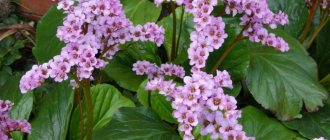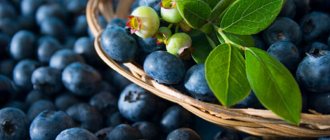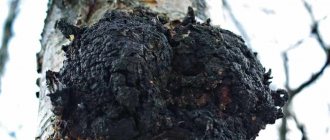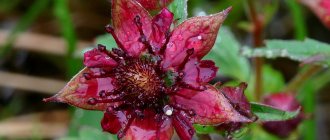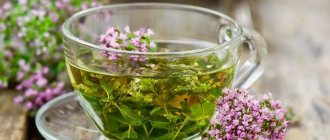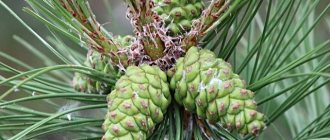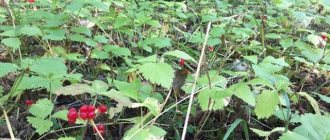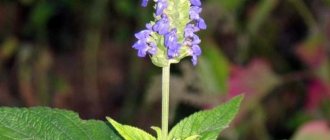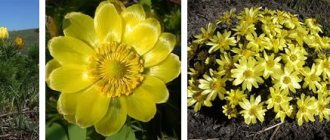Currant leaves are a natural product that has a wide range of healing properties. Even official medicine recognizes the benefits of leaves. This plant is native to Asia and Central Europe. Back in the 11th century, currant bushes were grown near monasteries, the fruits were eaten, and the leaves were used to prepare medicinal decoctions.
In Ancient Rus', this plant was not cultivated for a long time. It grew exclusively in the wild, and the bush got its name from the word “stink.” Due to their unpleasant odor, the fruits were considered poisonous for a long time.
| Calories per 100 g, (kcal): | 1 |
| Protein per 100 g, (g): | 0.1 |
| Fat per 100 g, (g): | 0.0 |
| Carbohydrates per 100 g, (g): | 0.1 |
| Glycemic index: | 0 |
Composition and calorie content of currant leaves, vitamins and minerals
Due to the high content of vitamin C, the leaves of the bush are widely used in the treatment of colds and to strengthen the immune system. In addition, they contain essential oils, carotene and phytoncides. The leaves contain a lot of flavonoids, catechin, protantocyanidin. These substances are famous for their antioxidant properties, which can even prevent the formation of cancer cells. For this reason, the leaves are often recommended for use in cases of oncology and genetic predisposition to this disease.
Currant leaves contain increased amounts of magnesium, phosphorus, calcium, potassium and sodium. In turn, minerals help strengthen bone mass and help build muscle.
Due to the complete absence of fat in the leaves and the minimal amount of carbohydrates and protein, the calorie content is only 1 unit.
Chemical composition of currants
The healing properties of currants are very important. Since ancient times, it has been used to treat and prevent various diseases. Moreover, this is even recognized by official medicine and pharmacology. Currant extract is used to produce many medicines. Such popularity and ease of use are characteristic of the chemical composition of plants.
| Vitamins | Minerals | ||||
| macronutrients | microelements | ||||
| A | 17 mcg | Calcium | 36 mg | Iron | 13 mg |
| IN 1 | 0.003 mg | Potassium | 350 mg | Zinc | 0.13 mcg |
| AT 2 | 0.004 mg | Phosphorus | 33 mg | Iodine | 1 mcg |
| AT 5 | 0.4 mg | Magnesium | 31 mg | Cobalt | 1 mcg |
| AT 6 | 0.1 mg | Sulfur | 152mg | Manganese | 0.18 mg |
| AT 9 | 5 mg | Chlorine | 14 mg | Copper | 130 mcg |
| WITH | 200 mcg | Molybdenum | 24 mcg | ||
| E | 0.07 mcg | Bor | 55mcg | ||
| N | 2.4 mg | Fluorine | 17 mcg | ||
| PP | 0.3 mg | ||||
The benefits of currant leaves for human health are invaluable from the point of view of both folk and modern medicine. They can get rid of many diseases and strengthen the body. It is often recommended to use during periods of vitamin deficiency, when a person is most susceptible to viral bacterial diseases.
What are the benefits of currant leaves?
In addition to using the leaves as a remedy for colds, they help cope with the negative effects of medicinal drugs on the body.
Decoctions are used for external disinfection of wounds and other skin lesions. The decoction is used to gargle for sore throat and bronchitis. The leaves can improve visual acuity and improve heart function. Improves brain activity and cleans blood vessels. Thanks to the ability to dilate blood vessels, the leaves normalize blood pressure.
The leaves have been scientifically proven to be effective in reducing the risk of developing Alzheimer's disease. For this purpose, leaf tea can be used not only as a separate drink, but also in a mixture with green tea.
The leaves have a positive effect on the skin, relieving irritation, eliminating prickly heat and dermatological diseases.
Composition of black currant leaves
Currant leaves contain a record amount of vitamin C - 260 mg per 100 g, while the daily requirement of the human body is 170 mg. They are also rich in essential oils, phytoncides, omega-3 and omega-6, pectin, and organic acids.
The plant has a wide vitamin and mineral complex:
- vitamin A;
- beta-carotene;
- B vitamins: B1, B2, B3, B4, B5, B6, B9;
- vitamin C;
- vitamin E;
- vitamin H;
- vitamin PP;
- macroelements: potassium, calcium, magnesium, sodium, silicon, sulfur, chlorine, phosphorus;
- trace elements: iron, iodine, cobalt, manganese, copper, molybdenum, selenium, fluorine, zinc.
Currant leaves contain sugars (7.3 g per 100 g) in the form of fructose, glucose, sucrose, as well as various glycosides, tannins and nitrogenous substances.
Currant leaf tea
It is recommended to supplement your daily diet with tea. It perfectly tones and has a general strengthening effect. The drink can act as a replacement for coffee and black tea.
Tea has a diuretic effect, so it is recommended in the presence of kidney pathologies, even as a means of removing stones and uric acid.
Tea is especially beneficial for the elderly. It stimulates metabolic processes and supports the heart muscle.
In the summer, it is recommended to add some raspberry leaves to currant tea to enhance the tonic effect. It is better to use honey as a sweetener, regardless of the time of year.
Cooking recipes
Black currant leaves and its medicinal properties are in demand for the prevention of many diseases and conditions, alleviation of existing pathologies. The leaves are used in the form of a decoction, infusion or fresh as part of multivitamin preparations.
ethnoscience
Products prepared from blackcurrant leaves are used in complex therapeutic measures or for preventive purposes. They have a gentle effect on the body, alleviate the severity of symptoms, reduce the need for medications, but their effectiveness is not enough to independently resist a specific disease. For this reason, preparations based on currant leaves are used as an adjuvant to the main therapy.
Decoction
This is a universal therapeutic and prophylactic remedy for arterial hypertension, atherosclerosis, diabetes mellitus, colds and other infectious diseases of the respiratory system. The decoction treats scrofula, scurvy, and replenishes the deficiency of vitamins and minerals in cases of hypo- and avitaminosis.
The recipe for making the decoction is quite simple:
- Fresh or dried currant leaves in the amount of 4 tbsp. l. pour 1 liter of boiling water.
- Place in a water bath and cook for 20-30 minutes over medium heat from the moment it boils. The broth is cooled and filtered.
Take 200 ml orally three times a day. The course of treatment and dosage may vary and depend on the severity of symptoms, the body's reaction and concomitant treatment.
Infusion
The infusion acts as a diuretic. It has proven itself especially well in the treatment of liver and kidney diseases, urolithiasis, and gout. Effectively relieves edema, reduces the load on the heart muscle, thereby alleviating hypertension. In addition, it is a natural immunostimulant and supports the normal functioning of the visual organs, sweat and sebaceous glands.
How to prepare the infusion:
- 5 tbsp. l. currant leaves are poured into an airtight container (it is better to use a thermos, but you can use a pan with a tight-fitting lid) and 1 liter of boiling water is poured.
- Leave at room temperature for 2-3 hours.
- The strained infusion is taken 3-4 times a day, 100 ml. The course of treatment is discussed with a specialist in a specific case.
Tea
Tea made from currant leaves tones, calms the nervous system, normalizes night sleep, and improves digestion. It is especially useful for people over 30 years of age, when natural age-related changes occur in the body, immune defense weakens and the risk of developing many diseases and conditions increases.
Reference. By regularly drinking this tea in adulthood, you can prevent diseases such as Alzheimer's disease, senile dementia, atherosclerosis, myocardial infarction, and hypertension.
Tea recipe:
- 4-5 currant leaves are poured with 250 ml of hot water.
- Let it brew for 2-3 minutes. To enhance the medicinal properties and improve the taste, honey, lemon, mint or lemon balm leaves are added to the drink if desired.
You can drink 3-4 cups of tea per day. Excessive consumption of the drink can cause the opposite effect and worsen the general condition.
Cosmetology
Black currant leaves are a proven remedy for treating a wide range of dermatological diseases: eczema, acne, dermatitis. For burns, diaper rash, and other violations of the integrity of the skin, they speed up the healing process and disinfect.
The biological components of the leaves help maintain skin health. They simultaneously reproduce several effects:
- tone;
- moisturize;
- prevent the appearance of early wrinkles;
- lighten;
- inhibit inflammatory processes;
- regulate the functioning of the sebaceous glands;
- protect the skin from the negative effects of sunlight;
- reduce the number of rashes, prevent the formation of new rash elements.
The effect of using black currant leaves is cumulative: in order to achieve the desired result, it is important to carry out the procedures systematically.
Advice. Before using a currant leaf mask on your face, check to see if there will be any unwanted reaction. To do this, apply the composition to the inside of your wrist, evaluate the reaction after 15-20 minutes. If no redness, peeling or rashes are detected, the mask can be applied to the face.
For acne
Cosmetologists recommend using black currant leaves as a compress for those with problematic, oily skin prone to rashes. The action of the product is aimed at suppressing the mechanisms of acne development: reducing sebum secretion, stopping inflammatory processes, and eliminating infection.
Main components:
- dried currant leaves - 20 g;
- chamomile inflorescences - 30 g;
- sea buckthorn fruits - 50 g;
- water - 1 l.
How to prepare a compress:
- All plant products are combined, poured with boiling water, placed in a water bath and cooked for about 20 minutes.
- The broth is cooled and filtered. Soak gauze in it, folded in several layers, wring it out lightly, and apply it to the face for 10-15 minutes.
The course on average consists of 5-7 daily procedures. However, this is all individual and depends on the nature and severity of acne, and the characteristics of the course of the disease.
For skin whitening
The main effect of the mask is to reduce the severity of pigmentation and prevent its appearance. In addition, this product tones and soothes well, increases skin elasticity, gives the face a matte and healthy color, and improves the penetration of vitamins and minerals deep into the dermis.
How to prepare a whitening mask at home:
- 5-10 clean currant leaves are ground in a blender or using a meat grinder.
- Combine the pulp from the leaves and 150 ml of yogurt and mix. The mixture is transferred to gauze folded in several layers and the juice is squeezed out.
- A thick paste is evenly applied to the face and neck area. Keep for 15-20 minutes. Repeat the procedure 2-3 times a week.
Decoctions and infusions of currant leaves
Tinctures and decoctions are used primarily to treat colds and pulmonary diseases. These drinks help cope with:
- bronchitis;
- cough;
- with inflammatory processes;
- atherosclerosis;
- dysentery.
The leaves are used in the presence of cardiovascular diseases and as a general tonic.
Currant tinctures are used as a lotion.
To prepare a decoction in one liter, boil 4 tablespoons of leaves in a water bath for about 30 minutes. After cooling, consume three times in equal parts throughout the day.
Tinctures are usually prepared in a thermos. A liter thermos will require 5 tablespoons of raw materials. Leave for 2 to 3 hours. Then filter, drink 3-4 times a day, half a glass. With the same setting, you can wipe your face or treat wounds to speed up the healing process.
Collection (procurement) of raw materials and preparation
The optimal time for collecting currant leaves is the flowering period of the bush.
The day should be sunny and dry. The time is chosen after 10 o'clock, when the dew has completely dried. Healthy leaves are cut from young shoots without signs of disease.
Scatter the raw materials in a well-ventilated shed or under a canopy that protects from sunlight. During the drying period, the raw materials must be systematically stirred.
For storage (no longer than three years), the dried leaves are poured into dry glass containers with lids or linen bags.
To prepare fragrant healing tea, fermented leaves are used, which are prepared according to the following algorithm:
- Fresh leaves are dried in the shade for 24 hours.
- To destroy the structures and achieve the release of juice, pass the raw materials through a meat grinder. A small amount can be ground using a mortar.
- Transfer evenly to a flat container and cover with a damp cloth.
- After 6 hours, scatter on a baking sheet and dry at 100 degrees in the oven. An indicator of readiness is the fragility of the mass.
Article for you:
Wild strawberries: medicinal properties and contraindications, berries, roots, leaves
Store in a glass container under a lid in a closet.
A variety of medicinal remedies are prepared at home using currant leaves.
Therapeutic bath of currant leaves
Baths with the addition of a decoction of currant leaves are taken in the presence of dermatitis and other problems with the epidermis. This method of treatment helps to cope with diathesis, prickly heat and radiculitis.
Baths with currant leaves are an excellent way to improve the structure of hair and nails.
For a therapeutic bath, not only leaves are used, but also bush branches. For 10 liters of water you will need 1 kg of branches and leaves of the plant, boil all this for 30 minutes, leave for about 1 hour, filter. After this, fill the bath with the broth, mix with warm water if necessary and take a bath for 25 minutes.
Infusion
In order to get rid of cough, strengthen the immune system, treat rheumatism, colds, gout, currant infusion is prepared, which additionally has an antimicrobial and calming effect.
Article for you:
Medicinal properties and use of cabbage leaves in folk medicine
Dial 5 tbsp. l. dried currant leaves. Place in a thermos, steaming with a liter of boiling water. After three hours of infusion, the drink is filtered. Every 6 hours, drink 100 ml of warm infusion.
This product helps clear the skin of acne. During the procedure, soak a cotton pad in the infusion and hold it on the problem area for 15 minutes.
The benefits of currant leaves for women
For women, currant leaves are very useful during menopause, as they help cope with symptoms and balance hormonal levels. For these purposes, you can drink tea and make decoctions.
The leaves of the bush effectively cope with swelling, stabilize blood pressure and strengthen the immune system.
Currant leaves are very useful for improving the structure of the skin. To do this, they not only wash themselves with tea, but also drink it.
Magnesium contained in the leaves normalizes the functioning of the nervous system and stimulates the functioning of the brain. Helps cope with insomnia and eliminate anxiety.
Rutin contained in the plant reduces the manifestations of varicose veins.
Features of application
Currant leaves are often used both in folk medicine and in cosmetology.
In folk medicine
Traditional healers very often use currant leaves - either as an independent remedy or as part of herbal preparations. The latter help in the treatment of a variety of diseases. Despite the fact that the moods and decoctions of currant leaf do not have pronounced pharmacological properties and the effect on the body of this remedy is not as pronounced as that of medicines, it is often much more rational to resort to this particular remedy than to pharmaceutical drugs.
Please note: you should not self-medicate even with such seemingly safe remedies as currant leaf! First of all, you need to consult a doctor to clarify the diagnosis and only then use folk remedies to help with the prescribed medications.
Decoctions of currant leaves are absorbed into the blood more slowly than infusions. They are intended for
recovery of the body after a serious illness or surgery;
- strengthening the immune system;
- improving the functioning of the nervous system;
- treatment of pyelonephritis, cystitis, urolithiasis, diabetes mellitus.
- Infusions act faster and the effect of their use is visible almost immediately. These funds:
- strengthen the immune system;
- eliminate depression;
- relieve chronic cough;
- increase the body's resistance;
- relieve gout symptoms;
- are an excellent remedy for arthritis;
- used as a diuretic;
- relieve swelling;
- reduce blood pressure.
Before using a decoction or infusion of currant leaf, be sure to consult your doctor.
In cosmetology
Blackcurrant leaves are actively used in cosmetology, as they are rich in all the necessary vitamins and microelements that help preserve its beauty and health. They cleanse and tone the skin, making it more elastic and firm.
Compresses and lotions made from currant leaf decoctions will help with problem skin, since due to the tannin content they contain, they dry the skin, tighten enlarged pores, and relieve inflammation.
Currant leaves will be needed to prepare a nourishing and toning face mask, which helps get rid of acne and restore damaged skin. To do this, you need to mix 150 milliliters of sour milk and one and a half tablespoons of currant leaves crushed into a pulp.
Currently reading: How to grow juniper at home
The product is thoroughly stirred and then applied to cleanly washed facial skin. After 20 minutes, the product is washed off with warm water. It is enough to carry out this procedure once a week.
To whiten your skin, a mask of one chicken egg, a teaspoon of oatmeal and the same amount of dried currant leaves is suitable. The product is applied to the area that needs to be whitened for 15 minutes, for example, to the area where freckles accumulate, then rinsed off with warm water.
If after using a product containing currant leaf you feel unwell, wash it off immediately, take an antihistamine and, if possible, consult a doctor.
The benefits of currant leaves for men
For the male body, drinks made from currant leaves are very useful for improving the functioning of the stomach. Tea prevents diarrhea and has anthelmintic properties.
Currants will help men cope with genitourinary diseases. Prevent the appearance of edema by removing excess fluid from the body. The leaves are also used to remove kidney stones.
Due to the presence of Omega-3 in the leaves, drinks remove “bad” cholesterol and prevent the onset of heart attack and stroke.
Tea made from the leaves is an effective preventative against the development of osteoporosis and other diseases of bones and joints.
Beneficial and medicinal properties of currant leaves
The raw materials contain vitamins, phytoncides, flavonoids, minerals, essential oils, tannins, acids, which explains the totality of beneficial properties of black currant. They can remove unnecessary fluid from the body due to their diuretic effect, lactic and oxalic acids, that is, thus preventing edema, urolithiasis and gout, and quickly restoring muscles after exercise.
Preparations from the leaves relieve inflammation, prevent the development of hypovitaminosis, asthenia, have a positive effect on the gastrointestinal tract, protect against viruses, are used for rheumatism, diabetes, skin and cardiovascular diseases, and reduce blood pressure. Folk remedies prepared from leaves help rejuvenate the body due to the fact that they stop the activity of free radicals that destroy cells. They are also recommended for decreased vision, although they are not as effective as the fruits of this plant.
Collection of leaves and proper preparation
Berries, leaves and buds are used for medicinal purposes. Raw materials are not prepared on an industrial scale. Therefore, if you want to dry the leaves, you will have to do it yourself. Harvesting season is June and July.
Collect those leaves that are not damaged by diseases (do not have spots). They are picked from the bush by hand. Dry in a room with good ventilation. To do this, they are laid out on paper in a layer no thicker than 3 cm. The yield of dry raw materials will be 34–37%. Dry leaves are packed in paper or fabric (breathable) bags. Store in a ventilated area. The shelf life of dried raw materials is unlimited.

